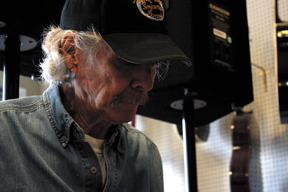During a brief phone conversation earlier this month, George Cummings, guitarist for the 1970s iconic pop band Dr. Hook & The Medicine Show, told how he had come to Bayonne from his home in Mississippi.
“I took a wrong turn on the Turnpike and wound up here,” he said. “That was 20 years ago.”
The truth, however, is even stranger than that, since Cummings made musical history, rising from the hard-hitting, gritty life of the club scene along Bergenline Avenue in Union City to being featured on the cover of the premier music magazine of the 1970s, “Rolling Stone Magazine,” with four or five top 20 hits.
In mid-March, Cummings may have made history again – although in a much less dramatic style – when he unpacked the latest creation of legendary Hartley Peavey, founder and CEO of Peavey Electronics Corporation and a well-known innovator in the musical equipment industry, at Pirro’s music store in Bayonne.
Cummings and Peavey
Peavey, along with Marshall and a handful of other companies, is considered one of the founders of modern rock and roll instruments.
Peavey, once a hopeful musician himself, learned early in life that he was better suited for making quality musical gear than playing it, and his amplifiers helped shepherd in the rock and roll era of the 1950s and 1960s. “The truth is, I’m the world’s worst guitar player,” Peavey once said.
Peavey’s first guitar was “a very used and abused” Les Paul Special he had painted white, which he eventually gave to Cummings, who still owns it.
“He [Cummings] was a great guitar player and was primarily responsible for introducing me to jazz,” said Peavey in a book about his company. “He later went on to be the lead guitar player for Dr. Hook & The Medicine Show and a songwriter for Dr. Hook and other groups in the Nashville area.”
Cummings, who developed the lap steel guitar style used on some of Dr. Hook’s better-known recordings, said he conversed with Peavey on the design of a new lap guitar that can be played standing up.
“This is so new, we don’t know what they’re going to charge for it yet,” Cummings said, unpacking the white guitar at Pirro’s in early March.
For about an hour, Cummings picked through a repertoire of classic lap guitar riffs as customers came and went, many pausing to watch the solo performance.
Cummings, who is considered one of the better performers on lap guitar, said he received no formal training and learned the instrument on his own, which eventually became part of Dr. Hook’s sound.
Began down South
Still an active performer, Cummings began his musical career in the South in 1956 and eventually made his way to the Chicago area as a member of a band called The Chocolate Papers.
A short time later, he came to the New York area where he co-founded a new band called Dr. Hook & The Medicine Show, and played clubs along the tough bar strip in Union City.
The band’s name was contrived while working in what was then The Bandbox in Union City. The owner asked Cummings and fellow members Ray Sawyer and Dennis Locorriere to come up with a name so they could post it on the sign outside. Cummings borrowed a pencil and wrote the band’s name out, based partly on Captain Hook from the children’s story “Peter Pan.”
In 1970, the band recorded its first album for Columbia Records. From it, the hit single “Sylvia’s Mother” was released. While the band has several other hits, they made musical history when they released a single called “Cover of the Rolling Stone,” a spoof about making it big when they saw their faces on the cover of that generation’s premier music publication.
“We got our pictures on it, too,” Cummings said, as he slid the metal bar across the new guitar.
During the early years of the band, Cummings gradually introduced the slide guitar into the music until it was considered an essential part of the band’s overall sound.
For health reasons, Cummings left the band in 1975, by which time the band had peaked and would break up within a few years.
Next step
After leaving the band, Cummings moved to Nashville, where he hooked up with other bands and penned a hit county record, “Moe & Joe,” and later won a Video of the Year Award.
Rock Legend Lonnie Mack recorded Cummings’ “Rock People,” the video of which featured another legendary guitarist, Stevie Ray Vaughn.
In the early 1990s, Cummings toured Europe with other American artists. In 2003, Cummings worked with Ken Hatley on the soundtrack for “Florida City,” a film drama about advance knowledge of the Pearl Harbor attack. Cummings has recently been re-mastering an album on Big Joe Williams at Muschel Shoals Studios, one of the last albums this Delta Blues singer recorded.
Until this guitar, performers of quality steel slide guitars were required to sit down.
________
The design for the new guitar came out of the need for performers to be able to stand up and still play. Until this guitar, performers of quality steel slide guitars were required to sit down, and even if they wanted to stand up, the instrument was so heavy and cumbersome that they could not perform.
The new lightweight instrument includes three strap hook-ups and a body cut out so that a performer can stand up with it and still use the slide, although during most of the hour-long tryout, Cummings reverted to tradition and played the instrument on his lap.
“It feels real good,” he said. “And it has a nice sound.”
